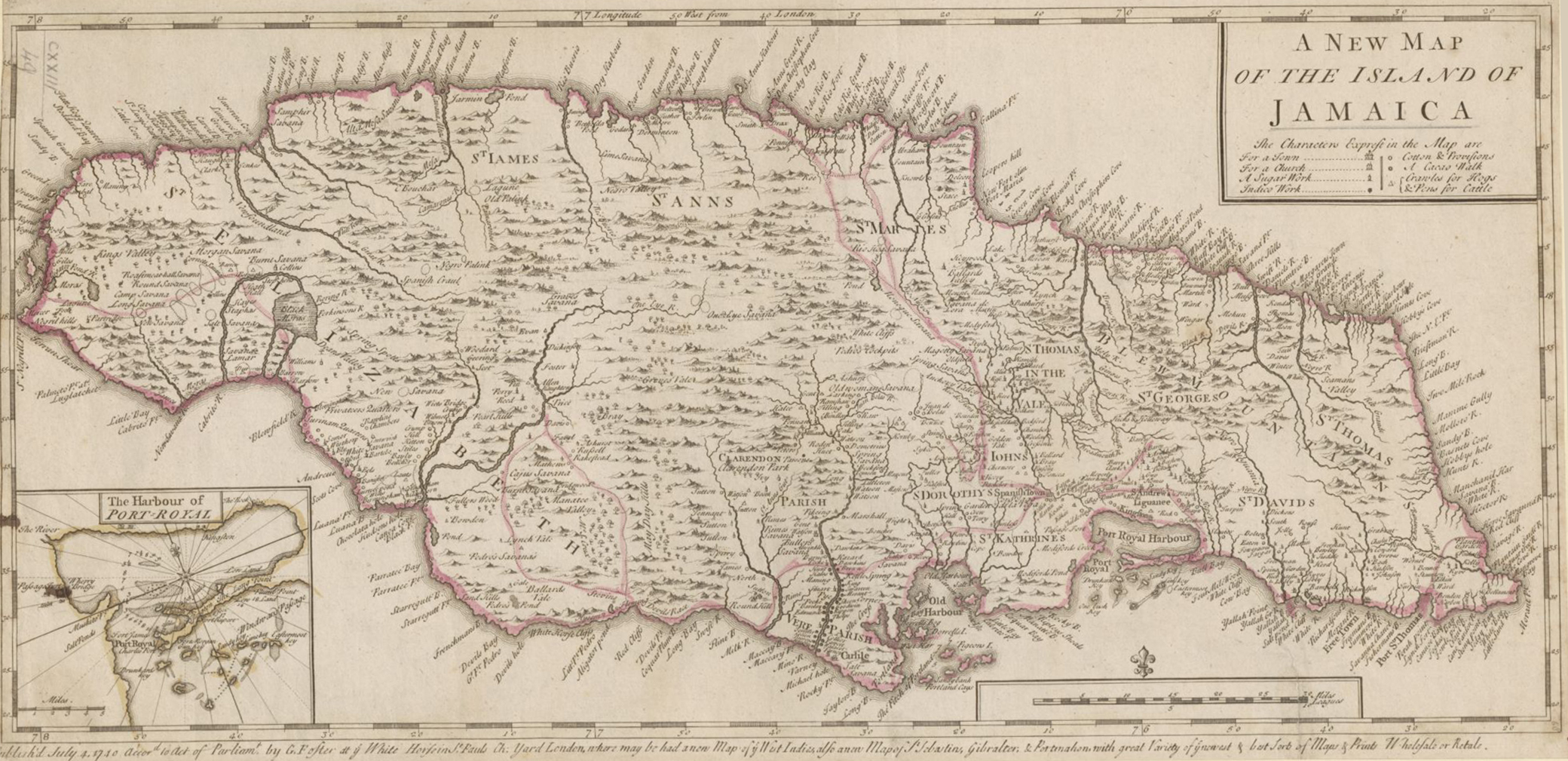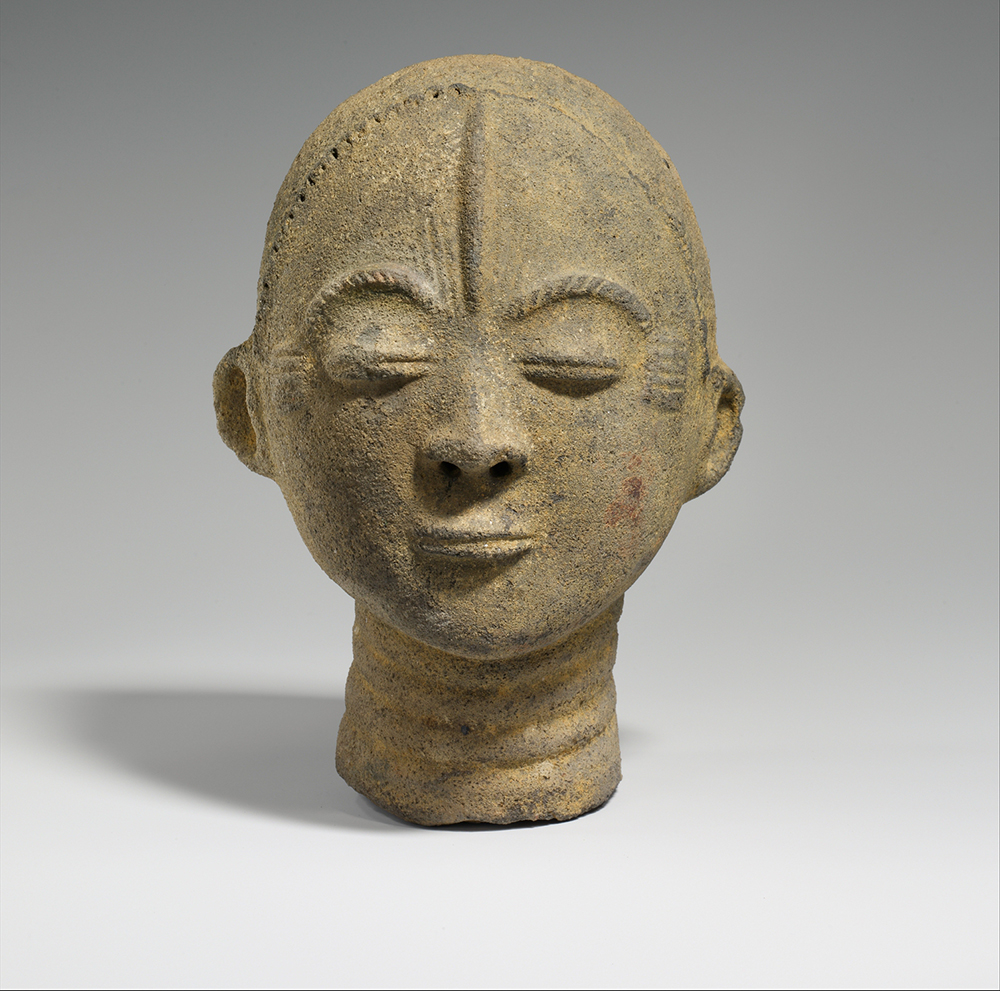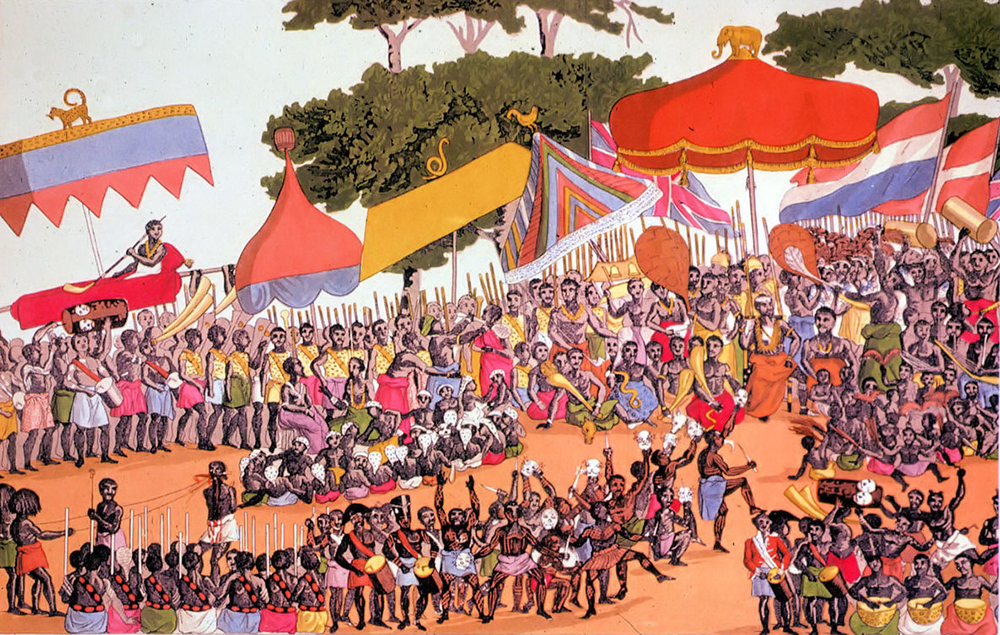
A New Map of the Island of Jamaica, 1740. British Library.
At mid-century more than nine of every ten people in Jamaica were enslaved. Between half and three-quarters of the enslaved had been born in Africa, and those Africans had come from an expansive area of the continent between the Senegal and Kongo Rivers, and even as far away as southeast Africa. Between 1701 and 1760, according to the best estimates, Jamaica received some 408,000 captives drawn from various regions of the African coast. But the distribution was neither random nor even. Fewer than fifteen hundred of these unfortunate people came from southeast Africa, and just over 8 percent of them embarked from the region stretching from the Senegambia through the Upper Guinea Coast to Cape Appolonia. One of every five came from west central Africa, with a similar proportion leaving the continent from the Bight of Biafra. More than half of all the Africans arriving in Jamaica came from the Gold Coast and the adjacent Bight of Benin, the so-called Slave Coast. In excess of 150,000 Africans, 37 percent of the total, came from the Gold Coast alone. These numbers reached a peak of 22,000 in the five years preceding the outbreak of the Seven Years’ War before falling back by nearly two-thirds between 1756 and 1760. Jamaica’s population was diverse indeed, but migrants from the Gold Coast represented its largest fraction, larger by far than the cohort of people from England and Scotland.
The breadth of these regional origins meant myriad languages, polities, and historical experiences. Yet, as they migrated, first within Africa and then across the Atlantic, the Africans found, shared, and made many commonalities. People regrouped with those who spoke similar languages, worshipped similar deities, or recognized similar forms of authority. From the designations foisted on them by the slave traders they made new categories of belonging: Angolas, Ebos, Papaws, Whidahs, and Coromantees, among others. Slaveholders imagined these peoples to be quite different in character. Often their impressions of Africans were nothing more than crudely drawn stereotypes, but even these caricatures were deeply rooted and could have far-reaching consequences.
In 1688, during his travels in Jamaica, the naturalist Sir Hans Sloane witnessed a diverse group of Africans performing at what he called a “festival.” He convinced a local musician with European training and an ear for black compositions—possibly one of the “Negro musicians” playing at the event—to document some of the pieces. In Sloane’s Voyage to the Islands of Madera, Barbados, Nieves, S. Christopher’s, and Jamaica, published in 1707, he listed short notations for “Papa” and “Angola” music and a longer, more complex section of “Koromanti” music, perhaps indicating that the latter variety enjoyed the greatest prominence. Already, in the late seventeenth century, slaves from various regions of Africa were recognized for distinct styles of cultural expression. And yet they articulated these differences at a convivial gathering where they could both continue the traditions of their birthplaces and create new ones in diaspora. That they might have learned to play and enjoy each other’s music suggests that neither their alliances nor their antagonisms were as predetermined by their origins as the slaveholders liked to assume.
Said to be from more than twenty different “Countries or Nations,” the Africans called by the British “Coromantees” garnered the most favorable commentary and inspired the most trepidation. Slave traders used the denomination to describe Africans from the Gold Coast generally, but slaveholders recognized that they were “of different Provinces or Clans, and not under the same Prince or Chief, nor do They speak the same language.” According to James Knight, Jamaican slaveholders preferred to own people who came from the better-known African polities near the coast, with whom Europeans had long maintained trading relations. These Africans were familiar with regimented labor, and their accustomed diet of maize, plantains, yams, and other ground provisions could be easily supplied in Jamaica. Coromantees were “ingenious,” wrote Knight, and in their youth could be “easily taught any Science or Mechanick Art.” He even praised them for being “neat & cleanly,” with good dental hygiene.

In Jamaica, the planters’ special preference for Coromantees coincided with a rampant hunger for laborers. In the fast-growing colony, planters lamented that the island was still “not one-tenth settled” in 1750. Slaves were desperately needed for the brutal and killing work of clearing and cultivating the land, and slavery grew rapidly in the parishes where new lands came into tillage after an internal war with the maroons ended in 1739. The enslaved populations of outlying and formerly marginal parishes such as St. James, Hanover, St. Mary, and St. Thomas in the East increased dramatically through the middle of the century, drawing in a disproportionate share of those newly arrived from Africa.
Even in more established parishes like Westmoreland, where there were already more than eleven thousand slaves in 1740, planters were eager to exploit more Africans, especially from the Gold Coast. People from that region made up nearly one-third of the 250 slaves on James Woodcock’s Westmoreland plantation—the remainder included a hundred creoles and seventy from other regions, including “Ebors Calabars etc.” By 1750 Woodcock had cultivated three hundred of his estate’s eleven hundred acres, backed up against the mountains a short distance from Thomas Thistlewood’s Egypt and Arthur Forrest’s Masemure estates, and leaving great areas of hilly woodland sloping up through the untamed areas between the Westmoreland, Hanover, and St. James parishes. Testifying before the Board of Trade, Woodcock confirmed that he had heard planters “complain for want of Gold Coast slaves” and that they generally “would rather chuse a majority of Gold Coast negroes” for their plantations. Owning eighty himself, he wanted no more. He found them to be “a dangerous people,” prone to rebellion.
Woodcock’s hesitation pointed to the double-edged nature of the slaveholders’ esteem. As most well knew, the same traits they admired in Coromantees made them exceedingly threatening as enemies. “They are not only the best and most faithful of our slaves,” the slaveholding Governor Codrington of the British Leeward Islands had written in 1701, “but are really all born Heroes.” He maintained this even upon hearing that fifteen Coromantees had slain Major Samuel Martin, a prominent planter and speaker of the House of Assembly in Antigua. “There is a difference between them and all other negroes beyond what ’tis possible for your Lordships to conceive,” he reported to the Board of Trade. Martin must have been “guilty of some unusual act of severity, or rather some indignity towards the Corramantes,” Codrington rationalized. He inferred from his own experience and from that of his father, who had held enslaved Africans for forty-five years, that Coromantees were “grateful and obedient to a kind master, but implacably revengeful when ill-treated.” As such, Coromantees represented both hazard and opportunity.
More than any other Africans, Coromantees had a worrisome reputation for rebellion. British commentators nearly always tempered their praise for the Coromantees’ attractive qualities with warnings about their supposedly warlike disposition. “They are Fractious, and in Their Nature Deceitful, Revengefull, & blood thirsty,” wrote Knight. They might be favored as slaves, but masters could be ruined by failing to respect the potential danger that Coromantees presented. They “require a stricter hand being kept over Them, than those of any other Country,” Knight urged, “for which reason every prudent Planter is cautious of having too many of Them in his Plantation; and therefore the common Custom is to mix other Countries with Them.” Knight and others believed that Coromantees posed a singular threat: “There never was as I have heard of in this or any other Colony any Plot or conspiracy but They were at the bottom of it.” He and other slaveholders had formed these views from a combination of conventional perception, historical precedent, direct experience, and tenacious prejudice.
Somewhat paradoxically, this stereotyping probably encouraged slaveholders to give Coromantees special roles and favors. What little is known about the selection of plantation drivers—those most directly responsible for enforcing discipline among the work gangs—suggests that they were most often Jamaica-born creoles. Yet slaveholders consistently valued Gold Coast Africans highly enough to elevate them above others in the plantation hierarchy. Arthur Forrest’s Wager, for example, served as a headman on Masemure plantation after serving aboard a Royal Navy warship. So, it seems, did the future rebel leader Tacky, who labored on an estate in Jamaica’s rapidly growing St. Mary’s Parish, which had recently absorbed many enslaved arrivals from the Gold Coast. Given his name, which was also the term in the Ga language for a man of royal office or lineage, Tacky would appear to have been a man of political and military importance from the area near Accra, and a Coromantee when he arrived in Jamaica. Perhaps the martial prowess that slaveholders perceived in Coromantee men resonated with the personal characteristics of their own mastery, which was militaristic and therefore capable of powerful assertions of will, and at the same time destructive—fractious, revengeful, and bloodthirsty. These were the kind of people who could make great empires—and destroy them, as well.
Slaveholders did not know much about the African societies and histories that made their captives who they were, but they distinguished among them nonetheless by drawing upon stories that had long circulated in print and by word of mouth. Their perceptions cohered around their view of the Gold Coast as a particularly war-torn region of the African continent. Long European interaction with this part of the coast, and a prominent English presence there, gave them some faint ideas of state development, warfare, and enslavement in Africa. In America, British colonists traded stories of multiple Coromantee rebellions in the hemisphere and pondered their implications for patterns of slave recruitment, management, and repression, comparing what they knew of others’ experiences with their own customary practice. They knew very little about how Coromantees identified with one another beyond the similarities in their languages, or how they organized and sought to maintain group cohesion—nor did they much care.

In recent historical analysis, the Coromantees have been described as members of a “loosely structured organization of conationals who socialized with and aided one another,” forming what contemporaries called a “nation” in the Americas. There was no direct antecedent to this “ethnicity” on the Gold Coast, where a common tongue was not enough to supersede local divisions. The nation comprised people who shared what are today known as Akan and other regional languages, recognizably familiar religious practices, some similar political ideals and symbols, and many principles of communal incorporation. Among their countrymen, Africans would recognize similar ways of worshipping the divine, gathering in fellowship, and burying the dead. As a basis of social communion in an environment where dislocation was the common experience, the nation could also provide a forum for planning, organizing, and staging revolts.
As a category of belonging, “Coromantee” was crosscut by many other axes of identification. Coromantees spoke more than one language and came from many different regions and kingdoms, from which they brought a variety of historical experiences. Just as importantly, once in Jamaica, they served different roles in the slave society. No amount of cultural similarity could resolve all the difficult negotiations of multiple interests and experiences among them. Even with their compatriots, enslaved Africans made friends and foes through a politics of belonging that made the debate about what it meant to be Coromantee in Jamaica as urgent as the forging of the identity itself. In the face of continual assaults on their personal dignity, slaves distinguished themselves by their political commitments as much as by ascribed classifications. Among the Coromantees, different ideas of how to live in slave society, how to evade its worst abuses, and how to destroy it altogether shaped their rebellions even as they recalled their prior experiences in Africa. This was an inherently unstable and contingent process, which raises doubts about the extent to which the Coromantee ever truly become one people. Rather, out of many came many others. This process played out across the treacherous martial geography that connected the Gold Coast to the Americas. The places slaves came from, the routes they traveled, and the places they went to all contributed to their political understanding. As they became Coromantees, enslaved Africans defined new spatial networks, attached distinctive meanings to places, and called upon their senses of locality to draw the boundaries that distinguished safe places from dangerous ones and outsiders from insiders. In the turbulent world of Atlantic warfare, nothing was more important than learning where and how to form loyal units, alliances, and coalitions in the face of superior power. They had won this wisdom through hard experience on the Gold Coast before coming to America, where they learned it anew and with different particulars. When enslaved Coromantees made war on their masters, they used these insights to chart courses through the fissures in colonial sovereignty.
Excerpt adapted from Tacky’s Revolt: The Story of an Atlantic Slave War by Vincent Brown, published by Harvard University Press. Copyright © 2020 by Vincent Brown. Used by permission. All rights reserved.
